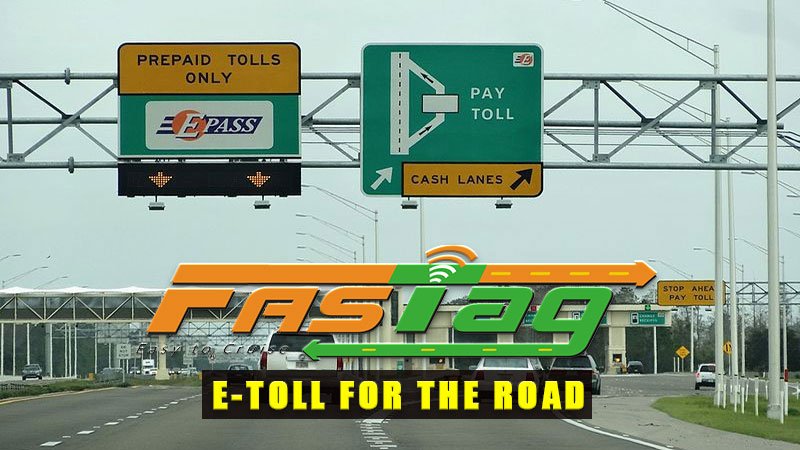How will the Fastag e toll collection programme help cut delays and losses on India’s highways?
The story so far: From December 15, 2019, FASTag, a prepaid rechargeable tag for toll payments, on national highways will become mandatory for all vehicles. The Ministry of Road Transport and Highways extended the earlier deadline of December 1 on Friday.
What is FASTag?
View our Blog: https://ensembleias.com/blog/
It is a prepaid radio-frequency identification-enabled tag that facilitates automatic deduction of toll charges. The new system will now do away away with a stop-over of vehicles and cash transactions at toll plazas. Projected as the ‘Aadhaar’ card for vehicles, the FASTag electronic toll collection programme is being implemented by the Indian Highways Management Company Limited (IHMCL), a company incorporated by the National Highways Authority of India (NHAI), and the National Payments Corporation of India in coordination with Toll Plaza Concessionaires, tag issuing agencies and banks.
Currently, FASTag can be bought from 22 certified banks, through various online platforms, online applications and at select points-of-sale locations.
The tag, which can be recharged through cheque or online payments, is fixed on the windshield of a vehicle, ideally on the glass just behind the rear-view mirror. It is scanned by the tag reader and the toll amount is deducted when the vehicle approaches a toll plaza. The user gets a short message service (SMS) alert on the registered mobile phone about all transactions and the available balance.
Visit our store at http://online.ensemble.net.in
Service providers have developed a ‘My FASTag’ mobile application to provide a one-stop solution to users. An NHAI prepaid wallet has also been launched, giving users the option of not linking the tags to their bank accounts.
FASTag has a validity of five years. Over 70 lakh FASTags had been issued till November 27.
Why does it matter?
A joint study in 2014-15 by the Transport Corporation of India and the Indian Institute of Management-Calcutta (launched by the Minister of Road Transport and Highways and Shipping Nitin Gadkari in 2016) estimated the cost of delay on Indian roads at $6.6 billion per year. The cost of additional fuel consumption due to delays was also put at $14.7 billion per year.
The study said: “The average cost of delay, including the shipper’s expenses, was ₹151.38 an hour. The figure may seem insignificant. However, the effect of delay on the economy is not insignificant… as per the Road Transport Year Book 2011-12, available on the Ministry of Road Transport and Highways website, there were about 7.6 million goods vehicles as on March 31, 2012, increasing at 8-9% per annum in the last couple of years. If we consider a conservative 8% growth, the number of goods vehicles as on March 31, 2015 is estimated at about 9.6 million, which means that the annual cost of delay to the Indian economy could be a whopping ₹432 billion or $6.6 billion.”
It added: “If mileage can be improved by increasing fuel efficiency, improving road conditions and reducing stoppage delays, the impact on the economy could be huge.”
The report had suggested that to expedite the toll collection process, India should gradually move towards electronic toll collection, which would not only reduce congestion and queues at toll plazas but also reduce operating costs for toll operators and plug revenue leakages.
How did it come about?
The electronic toll collection system was initially implemented as a pilot project in 2014 on the Ahmedabad-Mumbai stretch of the Golden Quadrilateral. It was gradually extended to other parts of the country. The tag is currently accepted at more than 500 National Highways and about 40 State highway toll plazas. Till September, the total collection through FASTag was over ₹12,850 crore.
What are the benefits?
Apart from plugging revenue leakages and reducing the cost of delays and fuel consumption, which is also likely to cut down the nation’s GDP loss, according to the government, the tag helps remove bottlenecks, ensures seamless movement of traffic and saves time. The centralised system provides authentic and real-time data to government agencies for better analysis and policy formulation. It also helps reduce air pollution and the use of paper besides cutting the cost of managing toll plazas.
What lies ahead?
On October 14, 2019, the IHMCL and GST Network signed a memorandum of understanding for integrating FASTag with the e-way Bill system. The arrangement has been made for a more efficient ‘track-and-trace’ mechanism involving goods vehicles. It will also check revenue leakage at toll plazas. The integration, which will become mandatory across the country from April 2020, will help revenue authorities check whether goods vehicles are actually headed to the specified destination. Suppliers and transporters will also be able to keep track of their vehicles through SMS alerts generated at each tag reader-enabled toll plaza.
The Central government also plans to enable the use of FASTag for a range of other facilities such as fuel payments and parking charges. Several States have already signed memoranda of understanding to join the system.
Source : The Hindu | Written by Devesh K. Pandey




